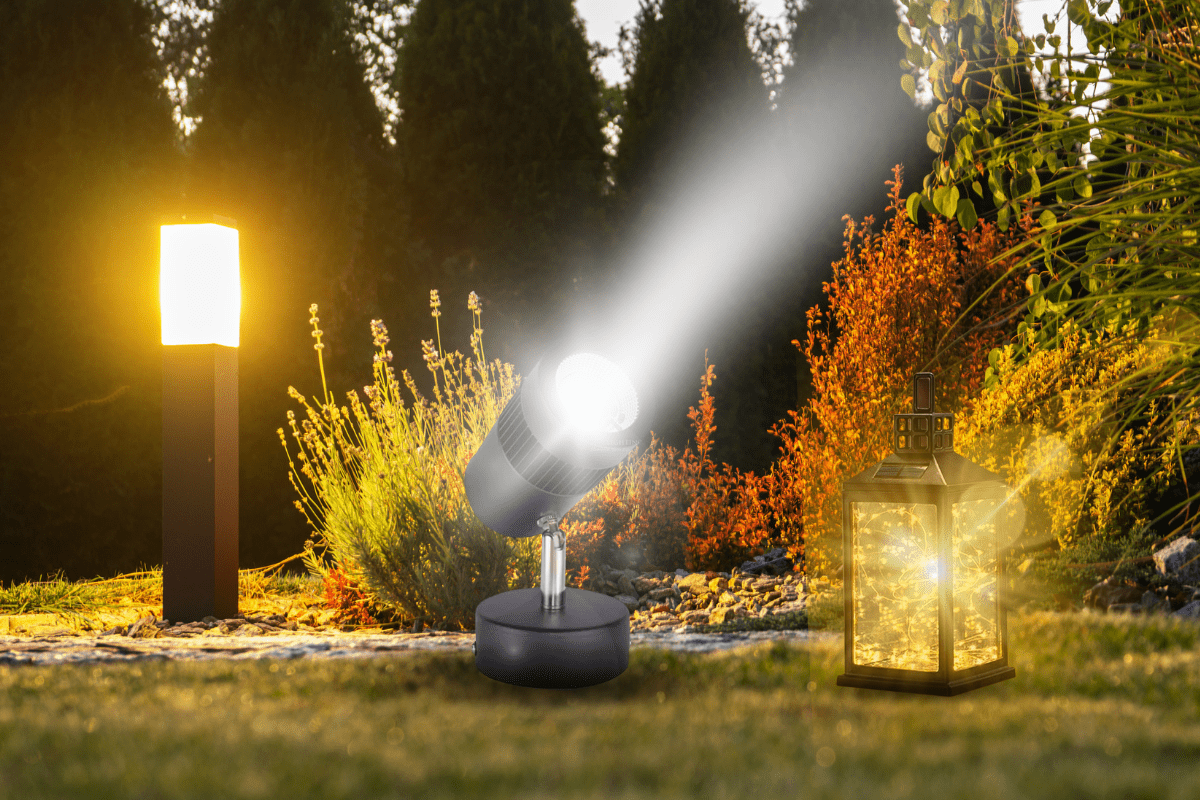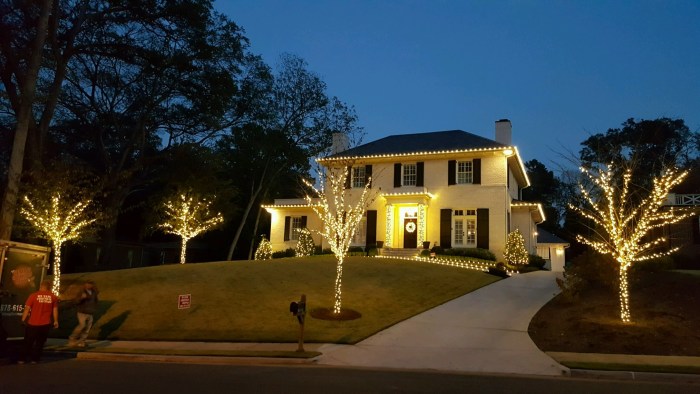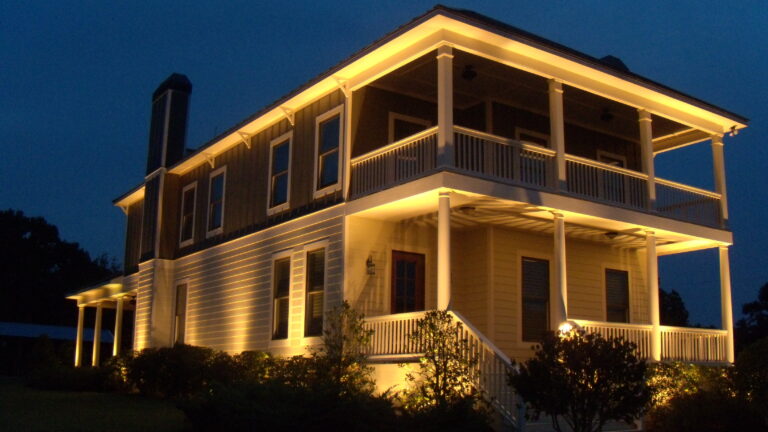Landscape Lighting Electrician Near Me
Finding a landscape lighting electrician near me is key to transforming your outdoor space. This guide walks you through the essential steps, from understanding lighting types and electrician expertise to evaluating quotes and ensuring a successful project.
We’ll delve into various lighting styles, exploring how different types of lights highlight specific features, from trees and gardens to water features. We’ll also discuss vital factors like safety, security, and the importance of licensed professionals. Understanding the electrician’s experience, certifications, and the crucial aspects of a comprehensive quote is essential to making the right choice.
Defining Landscape Lighting Needs
Landscape lighting transforms outdoor spaces, enhancing beauty and safety. Properly planned lighting can dramatically improve the aesthetic appeal of your property while increasing security and practicality. Understanding the various lighting options and their implications is crucial for effective design.
A well-designed landscape lighting plan considers the specific features of your property and the desired ambiance. Different types of lighting can highlight trees, flowerbeds, pathways, and water features, creating a unique and inviting atmosphere. Safety and security are also key considerations.
Types of Landscape Lighting
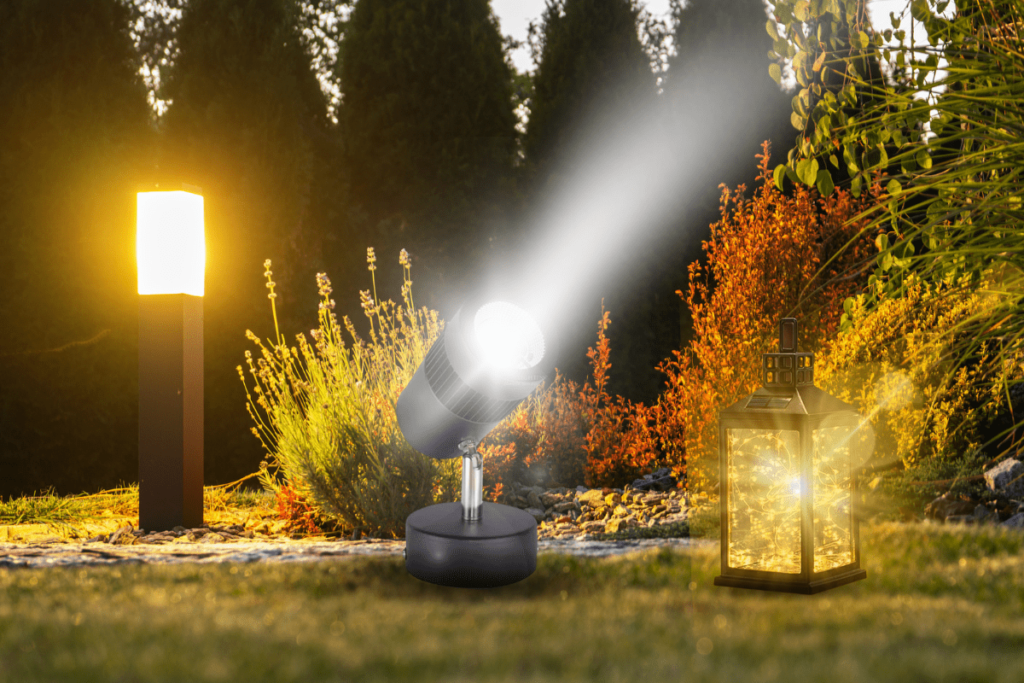
Landscape lighting encompasses a variety of fixtures, each serving a distinct purpose. Spotlights concentrate light on a specific area, perfect for highlighting individual plants or architectural elements. Floodlights provide wider coverage, ideal for illuminating larger areas like patios or gardens. Pathway lights guide movement along walkways and driveways, ensuring safety at night. Accent lighting subtly enhances the beauty of existing features, adding depth and dimension to the landscape.
Lighting Styles
Various lighting styles cater to diverse preferences. Modern styles often feature sleek, minimalist fixtures with a focus on clean lines and functionality. Traditional styles employ more ornate fixtures, drawing inspiration from classic design elements. Minimalist styles use subtle lighting to accentuate natural beauty, keeping the design understated. The chosen style significantly impacts the overall visual impression of the landscape.
Highlighting Landscape Features
Lighting can transform how landscape features are perceived. Trees can be highlighted with spotlights, showcasing their intricate shapes and textures. Flowerbeds and gardens benefit from accent lighting, drawing attention to vibrant blooms and foliage. Water features, such as ponds or fountains, can be dramatically enhanced with strategically placed spotlights, showcasing their movement and beauty. Water features can also be lit in various colors to add to their visual appeal.
Safety and Security Considerations
Safety and security are paramount when designing landscape lighting. Pathway lights along walkways ensure safe navigation at night. Security lighting around vulnerable areas deters potential intruders. Careful placement of lighting is critical, avoiding glare and ensuring visibility without compromising privacy.
Measuring the Lighting Area
Accurate measurements are essential for accurate quotes. Determine the dimensions of the areas to be illuminated. Account for the heights of trees and other elements. Understanding the desired level of illumination will inform the electrician’s estimate. The complexity of the installation and the number of fixtures required will also impact the quote. For instance, illuminating a large, complex garden with numerous trees and intricate pathways will result in a higher quote compared to illuminating a small patio area with a few simple fixtures.
Comparison of Landscape Lighting Types
| Type | Price | Durability | Energy Efficiency | Installation Difficulty |
|---|---|---|---|---|
| Spotlights | Medium | High | Medium | Medium |
| Floodlights | Low to Medium | High | Low | Low to Medium |
| Pathway Lights | Low | High | Medium | Low |
| Accent Lighting | Medium | High | Medium | Medium |
Note: Prices and difficulty levels are approximate and can vary based on specific products and installation requirements. Energy efficiency ratings can differ based on the type of LED technology used.
Identifying Electricians’ Expertise
Landscape lighting installations demand more than just basic electrical knowledge. Skilled electricians possess a unique blend of technical proficiency and practical experience to ensure safe, efficient, and aesthetically pleasing results. Their expertise extends beyond wiring, encompassing an understanding of outdoor environments, materials, and safety regulations.
Properly trained and experienced electricians are crucial for successful landscape lighting projects. Their expertise encompasses not only the electrical aspects but also the integration of lighting design with the overall landscape, ensuring longevity and compliance with local codes.
Essential Skills and Experience
A landscape lighting electrician requires a comprehensive skill set. This includes expertise in low-voltage wiring techniques, appropriate for outdoor use, as well as familiarity with various types of outdoor fixtures and their specific requirements. Understanding the nuances of different materials used in outdoor settings, such as metal, plastic, and concrete, is essential for proper installation and longevity. Knowledge of various fixture types, dimming systems, and control systems is vital for creating customized lighting solutions. Finally, the electrician should possess a strong understanding of how these components interact with the surrounding landscape to create the desired ambiance and functionality.
Significance of Proper Wiring, Safety Protocols, and Code Compliance

Proper wiring is fundamental to landscape lighting safety and performance. Incorrect wiring can lead to electrical hazards, malfunctions, and premature component failure. Electricians must meticulously follow the National Electrical Code (NEC) and local building codes, ensuring the installation meets safety standards. This involves proper grounding, circuit sizing, and insulation techniques. Safety protocols, such as using appropriate tools and protective gear, are equally important for preventing accidents and injuries. These protocols include lockout/tagout procedures and appropriate handling of materials.
Importance of Experience with Outdoor Elements and Materials
Outdoor environments present unique challenges for electrical installations. Experience with weathering, moisture, temperature fluctuations, and other environmental factors is crucial. Electricians must select materials and techniques that can withstand these conditions and ensure long-term reliability. For example, understanding how different materials, like aluminum and copper, react to moisture and corrosion is vital for choosing the appropriate wiring and fixtures. This practical knowledge helps prevent corrosion, short circuits, and other issues caused by outdoor elements.
Comparison of Electrical Certifications and Licenses
Various certifications and licenses validate electricians’ qualifications. These credentials signify a certain level of knowledge and competence in electrical work, particularly in landscape lighting. Licenses typically demonstrate adherence to industry standards and regulations. Electricians must be aware of the differences between certifications, as they often have different scopes and implications for specific tasks. Comparing certifications and licenses helps electricians understand their respective obligations and responsibilities in landscape lighting installations.
Importance of Licensed Electricians
Licensed electricians are crucial for the safety and liability of the project. Licenses ensure that electricians adhere to local building codes and safety standards. This legal requirement protects property owners and the public from potential hazards. It also ensures that the installation is done by a qualified professional, reducing the risk of accidents and ensuring the legality of the installation.
Certifications and Licenses for Landscape Electricians
| Certification/License | Description | Relevance to Landscape Lighting |
|---|---|---|
| State Electrical License | Required in most states to legally perform electrical work. | Ensures compliance with state-specific electrical codes. |
| National Electrical Code (NEC) Certification | Demonstrates knowledge of the NEC, which is a comprehensive set of electrical safety standards. | Essential for ensuring installations meet industry safety standards. |
| Specific Electrical Contractor Licenses | Validates experience and knowledge for a specific type of electrical work. | Demonstrates competence in landscape lighting installation. |
| Certifications from Trade Associations | Recognition from trade associations in the electrical industry. | Indicates adherence to best practices and advanced knowledge. |
Finding Local Electricians: Landscape Lighting Electrician Near Me
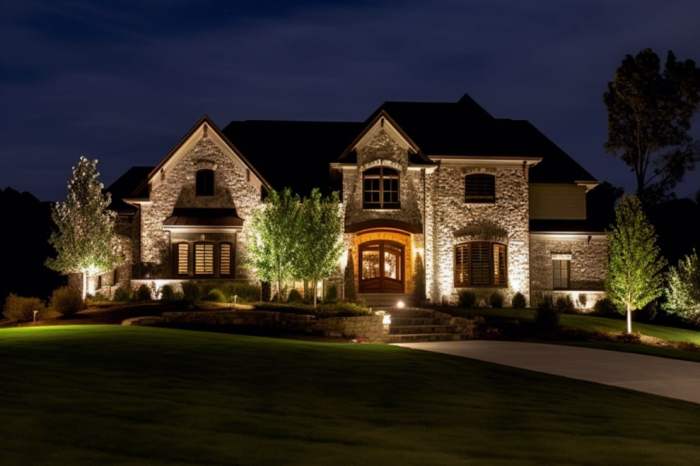
Source: brothersholidaylighting.com
Locating a qualified landscape lighting electrician is crucial for a successful project. This involves more than just a quick search; it necessitates careful consideration of expertise, reputation, and local availability. Proper research can save significant time and money in the long run.
Finding the right electrician for your landscape lighting needs involves several key steps. Thorough research and due diligence are essential for a positive outcome.
Methods for Locating Electricians
Several avenues exist for finding landscape lighting electricians in your area. Direct referrals from trusted sources are highly valued. Personal networks often provide valuable connections to experienced professionals.
Online Resources for Electricians, Landscape lighting electrician near me
Online platforms offer a wealth of information about landscape lighting electricians. Numerous websites and directories specialize in connecting clients with qualified professionals.
- Online search engines like Google, Bing, and DuckDuckGo can provide listings for landscape lighting electricians in your area. Using specific s, such as “landscape lighting electrician near me,” will refine your search results. These tools can also help you find local businesses specializing in landscape lighting design and installation.
- Specialized online directories cater to professionals in the home improvement and landscaping sectors. These resources often feature detailed profiles of electricians, including their certifications, experience, and portfolios. These listings can help narrow down your search based on specific criteria and expertise.
Verifying Electricians’ Credentials and Reputation
Ensuring the electrician’s qualifications and trustworthiness is paramount. Verify their licenses, insurance, and any relevant certifications.
- Checking the electrician’s licensing status is a critical step. Verify that the electrician holds the necessary licenses and permits to perform electrical work in your region. This information is typically available through local government websites or licensing boards.
- Insurance coverage is also essential. Confirm that the electrician has liability insurance to protect you in case of any accidents or damages during the project. This protects both the electrician and the client.
- Reviewing the electrician’s past projects or portfolios is beneficial. Look for evidence of successful installations, high-quality work, and client testimonials. A strong portfolio suggests a reliable and skilled professional.
Importance of Reviews and Testimonials
Customer reviews and testimonials provide valuable insights into an electrician’s work ethic and service quality.
- Online review platforms like Yelp, Google My Business, and Angie’s List offer valuable insights into past customer experiences. Reading reviews and testimonials provides a clear picture of the electrician’s performance, communication style, and overall reliability. Be sure to carefully consider both positive and negative feedback.
Using Online Search Tools for Local Electricians
Online search tools offer precise results when searching for electricians in a specific area.
- Utilize location-based search features on online search engines. Adding your city and state to your search query will provide results specifically for electricians in your area.
- Use specialized search filters on online directories to find landscape lighting electricians with specific experience or qualifications. Filtering by area, experience level, and pricing can refine your search and lead you to the best possible match.
Online Directories and Review Sites
This table provides a concise overview of common online resources for finding landscape lighting electricians.
| Directory/Review Site | Description |
|---|---|
| Google My Business | Allows businesses to manage their online presence and provides customer reviews. |
| Yelp | A popular review site with user-submitted reviews and ratings. |
| Angie’s List | Focuses on home services, including electrical work, with verified reviews and ratings. |
| Houzz | A platform for connecting with home improvement professionals, including electricians. |
| A professional networking platform that allows you to find electricians and their credentials. |
Evaluating Electrician Quotes
Getting multiple quotes from landscape lighting electricians is crucial for securing the best value and ensuring a quality installation. This process involves careful comparison of not just pricing, but also the scope of work, the expertise of the electrician, and the details of the proposed plan. Thorough evaluation of quotes allows you to make an informed decision that aligns with your needs and budget.
Understanding the specifics of each quote is key to choosing the right electrician. This includes meticulously reviewing the details, identifying potential hidden costs, and ensuring that the proposed project fully addresses your landscape lighting goals.
Organizing and Comparing Quotes
A structured approach to comparing quotes from different electricians is essential. Create a spreadsheet or document to record details from each quote. This allows for a side-by-side comparison of pricing, services, and any special considerations. Include the electrician’s name, contact information, date of quote, and a summary of the proposed project.
Components of a Comprehensive Landscape Lighting Quote
A comprehensive landscape lighting quote should detail all aspects of the project, including materials, labor, and any additional fees. This transparency helps in understanding the full scope of the project. It is important to look for details on the type and quality of the fixtures, the wiring and installation methods, and the labor costs associated with the work.
- Project Description: A clear article of the lighting plan, including the location and type of fixtures needed. This should include specific details like fixture models, wattage, and any unique features (e.g., motion sensors).
- Materials: A list of all materials, including fixtures, wiring, transformers, and any necessary conduit or other supporting components. This should specify the manufacturer and model numbers for each item.
- Labor Costs: A breakdown of labor charges for installation, including the number of hours, hourly rates, and any travel fees.
- Permitting Fees (if applicable): These fees should be identified and itemized separately, and should reflect the necessary approvals from local authorities.
- Wiring and Installation Details: A detailed description of the wiring method, including the type of wire, conduit size, and any specific safety measures implemented. This should also specify whether underground or above-ground wiring is planned, along with the methodology.
- Warranty Information: The length of the warranty on the materials and labor, as well as any specific conditions of the warranty. A detailed warranty ensures a commitment from the electrician and safeguards your investment.
Identifying Hidden Costs and Extra Charges
Be wary of vague language in a quote. Look for terms like “additional costs,” “site-specific adjustments,” or “unexpected challenges.” Inquire about the reasons for these items and seek clarification on any potential hidden charges. Request a detailed breakdown of any extra charges to understand their necessity and justify their inclusion.
Comparing Pricing Based on Project Scope and Quality
When comparing quotes, consider the project’s scope and the quality of materials and labor offered. A lower price might not always mean the best value. Compare the specifications of the lighting fixtures, the warranty offered, and the reputation of the electrician. A reliable electrician with experience in similar projects is a valuable asset. Evaluate the proposed plan to ensure it aligns with your long-term needs and vision for the landscape.
Essential Components of a Landscape Lighting Quote (Table)
| Component | Description |
|---|---|
| Project Description | Detailed article on the lighting plan, fixtures, and features. |
| Materials | List of all materials, including fixtures, wiring, and transformers. |
| Labor Costs | Breakdown of labor charges, hours, and hourly rates. |
| Permitting Fees | Itemize the cost of any necessary permits. |
| Wiring and Installation Details | Description of wiring method, conduit, and safety measures. |
| Warranty Information | Length and conditions of warranty on materials and labor. |
| Hidden Costs | Clear explanation of any extra charges or potential adjustments. |
Potential Costs for Different Landscape Lighting Projects (Table)
| Project Type | Estimated Cost Range (USD) |
|---|---|
| Small Residential (10-15 fixtures) | $1,500-$3,000 |
| Medium Residential (20-30 fixtures) | $3,000-$5,000 |
| Large Residential (30+ fixtures) | $5,000+ |
| Commercial Property (extensive use of fixtures) | $10,000+ |
Selecting the Right Electrician
Choosing the right landscape lighting electrician is crucial for a successful and long-lasting installation. This selection process involves more than just picking the lowest bidder; it necessitates careful consideration of communication, contractual agreements, and the electrician’s expertise. A well-chosen electrician ensures the project aligns with your vision, meets safety standards, and is completed efficiently.
Effective communication and clear expectations are paramount. This proactive approach helps avoid misunderstandings and ensures the project’s final product matches your initial vision. Defining the project’s scope, timeline, and payment terms upfront minimizes potential conflicts.
Establishing Clear Communication and Expectations
Open and consistent communication with the chosen electrician is essential for a smooth project execution. This includes discussing your design vision, preferences, and specific requirements in detail. Regular updates regarding the project’s progress are vital for addressing any concerns promptly. A transparent communication channel fosters trust and ensures everyone is on the same page.
Defining a Well-Defined Contract

A comprehensive contract is a critical step in ensuring a successful project. It articulates the project scope, including the specific lighting fixtures, installation locations, and materials. Detailed timelines for each phase of the project, from design to completion, are essential. Clearly defined payment terms, including the schedule of payments, will help manage financial expectations. A well-drafted contract also clarifies the responsibilities of both parties and addresses potential disputes. It acts as a safeguard for both the homeowner and the electrician.
Reviewing and Signing the Contract
Thoroughly reviewing the contract before signing is paramount. Pay close attention to the project scope, timelines, payment terms, warranty information, and any other relevant details. If any aspects of the contract are unclear, seek clarification from the electrician. Don’t hesitate to ask questions to ensure complete understanding of the agreement. Seeking legal counsel, if needed, is also a wise precaution. Having a clear and well-defined contract ensures that both parties are in agreement about the project’s details.
Getting Multiple Bids
Obtaining multiple bids from different landscape lighting electricians is highly recommended. This allows you to compare pricing, project scopes, and the expertise of various professionals. Comparing proposals from different electricians provides a more comprehensive understanding of the landscape lighting market, potentially uncovering hidden costs or unexpected fees. This comparison helps in making a more informed decision about the most suitable electrician for your project.
Questions to Ask Potential Electricians
During consultations with potential electricians, ask specific questions about their experience, their understanding of your project requirements, and their approach to installation. Examples of questions to ask include:
- What is your experience with landscape lighting projects similar to mine?
- Can you provide references from previous clients?
- What are your pricing strategies, and what factors influence the costs?
- What safety measures will you implement during the installation process?
- What is your estimated timeline for completing the project?
- How will you handle potential issues or unforeseen circumstances?
- What warranty or guarantee do you offer for your work?
These inquiries ensure you’re selecting an electrician with the right skills and experience for your specific needs.
Important Clauses and Considerations for a Landscape Lighting Contract
A well-structured contract should include specific clauses addressing potential issues. This protects both the homeowner and the electrician. The table below highlights crucial elements to consider when reviewing landscape lighting contracts:
| Clause | Considerations |
|---|---|
| Project Scope | Clearly defined tasks, materials, and timelines. |
| Payment Terms | Specific payment schedule and methods. |
| Timeline | Realistic deadlines and penalties for delays. |
| Warranty | Coverage period and procedures for repairs. |
| Dispute Resolution | Methods for addressing disagreements. |
| Permitting | Responsibilities for obtaining necessary permits. |
| Liability | Insurance and protection against potential damages. |
Understanding Project Timeline and Costs
Planning a landscape lighting project requires a realistic understanding of both the timeline and associated costs. A well-defined project schedule, coupled with a comprehensive budget, can help avoid potential delays and financial surprises. This section provides insights into typical project durations, factors influencing timelines, common payment structures, cost management strategies, and budget examples.
Estimated Project Timelines
Project timelines for landscape lighting installations vary significantly based on the project’s scope and complexity. Simple installations, involving a few fixtures and straightforward wiring, might take a few days to complete. More extensive projects, encompassing multiple zones, intricate designs, and complex wiring, can take several weeks.
- Simple projects (e.g., a few spotlights around a patio): A typical timeframe for these installations is 1-3 days, depending on site access and weather conditions.
- Medium-sized projects (e.g., lighting a pathway and several trees): These projects typically take 3-7 days to complete, accounting for the additional design and installation elements.
- Large-scale projects (e.g., extensive lighting for a large garden or estate): Projects of this nature often span 7-14 days, or even longer, due to the increased complexity and the larger number of fixtures and wiring involved.
Factors Influencing Project Timelines
Several factors can impact the overall project duration. The complexity of the design, the size of the area to be lit, and unforeseen circumstances like weather conditions can all play a role.
- Complexity of the design: A sophisticated lighting scheme with multiple zones, different fixture types, and intricate wiring will naturally take longer to install than a simpler, more straightforward layout.
- Size of the project area: A larger landscape area necessitates more fixtures, wiring, and installation time. The greater the area, the longer the timeline.
- Weather conditions: Adverse weather, such as heavy rain or extreme temperatures, can impact the installation process, potentially delaying the completion date.
Common Payment Structures
Payment structures for landscape lighting installations are often agreed upon in advance and are usually designed to be transparent and fair to both the client and the electrician. These structures can be a combination of methods, and the chosen method is often tailored to the project scope and the client’s preferences.
- Fixed-price contracts: This common structure involves a pre-determined price for the entire project. It provides clarity and predictability for the client while offering security for the electrician. It is often chosen for smaller projects with a clear scope.
- Time-and-materials contracts: This structure involves payment based on the electrician’s time spent on the project and the cost of materials used. It is typically suitable for larger, more complex projects where the exact scope might not be fully defined initially.
Managing Project Costs Effectively
Effective cost management involves careful budgeting, thorough material estimations, and clear communication with the electrician.
- Creating a Realistic Budget: Develop a detailed budget that includes materials, labor, permits (if required), and potential contingencies. A comprehensive budget will avoid cost overruns.
- Obtain multiple quotes: Comparing quotes from different electricians helps in identifying potential variations in pricing and ensures the client receives the most competitive rates for the project.
- Negotiate terms: If the client is satisfied with the electrician’s proposal, negotiations can be conducted to arrive at an agreement that is favorable to both parties.
Example Budget for a Landscape Lighting Project
A typical budget for a medium-sized landscape lighting project (e.g., pathway and several trees) might include the following:
| Category | Estimated Cost |
|---|---|
| Materials (fixtures, wiring, transformers) | $1,500 |
| Labor | $2,000 |
| Permitting (if required) | $100 |
| Contingency | $500 |
| Total Estimated Cost | $4,100 |
Project Timeline Comparison
The table below demonstrates a comparative overview of typical project timelines based on project scope:
| Project Scope | Estimated Timeline (days) |
|---|---|
| Simple (few fixtures) | 1-3 |
| Medium (pathway, trees) | 3-7 |
| Large (extensive garden) | 7-14+ |
Ensuring Project Success
A successful landscape lighting project hinges on meticulous planning, competent execution, and proactive problem-solving. This phase focuses on the crucial steps to guarantee the quality and safety of the completed installation, addressing potential issues, and ensuring long-term satisfaction for the client.
Quality and Safety Measures
Careful planning and execution are paramount to ensuring a high-quality and safe landscape lighting installation. This includes a thorough review of the project plan, ensuring all necessary permits are obtained, and confirming that the electrician possesses the required licenses and insurance. Adherence to all electrical codes and safety regulations is critical throughout the installation process. This involves using appropriate safety equipment, properly grounding the system, and maintaining a safe work environment. Inspecting materials and verifying that all components are functioning as expected during the installation is essential.
Addressing Potential Issues
During any construction project, unforeseen circumstances can arise. A proactive approach to potential issues is crucial. This includes a clear communication channel between the electrician and the client to address any concerns promptly. Having a contingency plan in place to handle unforeseen problems is also advisable. A well-defined scope of work and a comprehensive contract, outlining responsibilities and potential solutions, can help mitigate risks and prevent disputes.
Follow-up and Maintenance
Post-installation maintenance is vital for the longevity and optimal performance of the landscape lighting system. Regular inspections and maintenance are crucial for identifying and resolving potential problems early. A well-defined maintenance schedule, agreed upon with the client, ensures timely inspections and necessary repairs.
Post-Installation Maintenance Recommendations
Regular checks of all connections and components are crucial. This includes examining for any signs of damage, corrosion, or loose wiring. Monitoring the system’s performance over time is essential to identify any issues before they escalate. A scheduled inspection, ideally performed annually, can help maintain the system’s efficiency and prevent costly repairs. This should be detailed in the final contract.
Importance of a Warranty
A warranty on the work provides a level of assurance and protection for the client. It guarantees that the electrician stands behind their work and is committed to resolving any issues that may arise within a specified timeframe. A strong warranty demonstrates the electrician’s confidence in the quality of their work and commitment to customer satisfaction.
Potential Issues and Solutions Table
| Potential Issue | Possible Solution |
|---|---|
| Faulty Wiring | Identify and replace the faulty wiring section, ensuring adherence to electrical codes. |
| Dimmed or Inconsistent Lighting | Check the bulb wattage, ensure correct fixture type and voltage, and verify correct connections. |
| Moisture Damage | Identify the source of moisture and implement solutions to prevent further damage, such as sealing fixtures or rerouting wiring. |
| Unwanted Light Spillage | Adjust fixture positioning or add shielding components to control light dispersion. |
| Power Fluctuations | Assess the stability of the power supply and implement surge protection measures, if needed. |
| Bulb Failure | Maintain a readily available supply of replacement bulbs. Regular checks of bulbs are critical. |
Ending Remarks
In conclusion, finding the right landscape lighting electrician near you involves careful consideration of various factors. From evaluating lighting styles and electrician expertise to scrutinizing quotes and understanding project timelines, this guide provides a comprehensive approach. By following these steps, you can confidently select a qualified electrician, ensuring a safe, well-executed project that enhances your outdoor living space.
